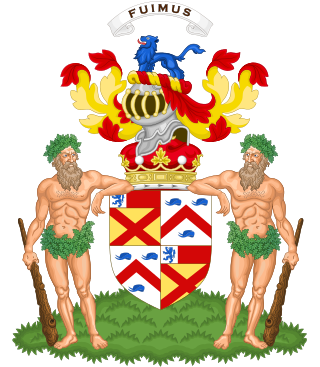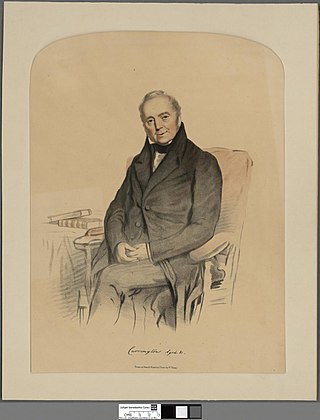
Baron Lyttelton is a title that has been created once in Peerage of England and twice in Peerage of Great Britain, both times for members of the Lyttelton family. Since 1889 the title has been a subsidiary title of the viscountcy of Cobham.

Marquess of Bath is a title in the Peerage of Great Britain. It was created in 1789 for Thomas Thynne, 3rd Viscount Weymouth. The Marquess holds the subsidiary titles Baron Thynne, of Warminster in the County of Wiltshire, and Viscount Weymouth, both created in 1682 in the Peerage of England. He is also a baronet in the Baronetage of England.

Marquess of Ailesbury, in the County of Buckingham, is a title in the Peerage of the United Kingdom. It was created on 17 July 1821 for Charles Brudenell-Bruce, 2nd Earl of Ailesbury.

Earl of Craven, in the County of York, is a title that has been created twice, once in the Peerage of England and once in the Peerage of the United Kingdom.

Earl of Romney is a title that has been created twice.

Earl of Cottenham, of Cottenham in the County of Cambridge, is a title in the Peerage of the United Kingdom. It was created in 1850 for the prominent lawyer and Whig politician Charles Pepys, 1st Baron Cottenham. ) He served as Lord Chancellor from 1836 to 1841 and from 1846 to 1850. Pepys had already been created Baron Cottenham, of Cottenham in the County of Cambridge, in 1836, and was made Viscount Crowhurst, of Crowhurst in the County of Surrey, at the same time he was given the earldom. These titles are also in the Peerage of the United Kingdom. The viscountcy is used as a courtesy title for the Earl's eldest son and heir apparent.

Earl of Selborne, in the County of Southampton, is a title in the Peerage of the United Kingdom. It was created in 1882 for the lawyer and Liberal politician Roundell Palmer, 1st Baron Selborne, along with the subsidiary title of Viscount Wolmer, of Blackmoor in the County of Southampton. He had already been made Baron Selborne, of Selborne in the County of Southampton, in 1872, also in the Peerage of the United Kingdom. Both his son, the second Earl, and grandson, the third Earl, were prominent Liberal Unionist politicians. The latter was in 1941 called to the House of Lords through a writ of acceleration in his father's barony of Selborne. The third Earl's grandson, the fourth Earl, served as one of the ninety elected hereditary peers that remain in the House of Lords after the passing of the House of Lords Act 1999, and sat as a Conservative. As of 2021, the titles are held by the latter's son, the fifth earl, who succeeded his father in that year.
Viscount Hampden is a title that has been created twice, once in the Peerage of Great Britain and once in the Peerage of the United Kingdom. The first creation came in the Peerage of Great Britain when the diplomat and politician Robert Hampden, 4th Baron Trevor, was created Viscount Hampden, of Great and Little Hampden in the County of Bedford on 14 June 1776. The title of Baron Trevor, of Bromham, had been created in the Peerage of Great Britain in 1712 for his father, the lawyer Sir Thomas Trevor. Both titles became extinct in 1824 on the death of the first Viscount's second son, the third Viscount.

Viscount Knollys, of Caversham in the County of Oxford, is a title in the Peerage of the United Kingdom. It was created in 1911 for the court official Francis Knollys, 1st Baron Knollys, Private Secretary to the Sovereign from 1901 to 1913. He had been previously created Baron Knollys, of Caversham in the County of Oxford, on 21 July 1902. His son, the second Viscount, served as Governor of Bermuda. As of 2023 the titles are held by the latter's grandson, the fourth Viscount, who succeeded in 2023. The third Viscountess Knollys was a sister of Baron Farnham: she served as Vice Lord-Lieutenant of Norfolk.
Viscount Leathers, of Purfleet in the County of Essex, is a title in the Peerage of the United Kingdom. It was created on 18 January 1954 for the businessman, Conservative politician and public servant Frederick Leathers, 1st Baron Leathers. He had already been created Baron Leathers, of Purfleet in the County of Essex, on 19 May 1941, also in the Peerage of the United Kingdom. As of 2020 the titles are held by his grandson, the third Viscount, who succeeded his father in 1996.
Viscount Mackintosh of Halifax, of Hethersett in the County of Norfolk, is a title in the Peerage of the United Kingdom. It was created on 10 July 1957 for the businessman and public servant Harold Mackintosh, 1st Baron Mackintosh of Halifax. He was the owner of the confectionery business of John Mackintosh & Sons Ltd and for many years Chairman of the National Savings Committee. Mackintosh had already been created a baronet, of Halifax in the West Riding of the County of York, in the Baronetage of the United Kingdom on 28 January 1935, and Baron Mackintosh of Halifax, of Hethersett in the County of Norfolk, on 6 February 1948, also in the Peerage of the United Kingdom. As of 2023 the titles are held by his grandson, the third Viscount, who succeeded his father in 1980.

Viscount Samuel, of Mount Carmel and of Toxteth in the City of Liverpool, is a title in the Peerage of the United Kingdom. It was created on 8 June 1937 for the Liberal politician and former High Commissioner of the British Mandate of Palestine, Herbert Samuel. His grandsons, the third and fourth Viscounts, were respectively a prominent Israeli chemist and neurobiologist, and an oil executive. As of 2014 the title is held by the 4th Viscount's son, who succeeded as fifth Viscount in that year.

Baron Carrington is a title that has been created three times, once in the Peerage of England, once in the Peerage of Ireland and once in the Peerage of Great Britain.

Baron Harmsworth, of Egham in the County of Surrey, is a title in the Peerage of the United Kingdom. It was created in 1939 for the Liberal politician Cecil Harmsworth, Under-Secretary of State for Foreign Affairs between 1919 and 1922. As of 2017 the title is held by his grandson, the third Baron, who succeeded his uncle in 1990.

Baron Sandhurst, of Sandhurst in the County of Berkshire, is a title in the Peerage of the United Kingdom. It was created on 28 March 1871 for the soldier Sir William Mansfield, Commander-in-Chief of India between 1865 and 1870 and Commander-in-Chief of Ireland between 1870 and 1875. He was the grandson of Sir James Mansfield, Solicitor-General and Chief Justice of the Common Pleas. Lord Sandhurst's eldest son, the second Baron, was a Liberal politician and also served as Governor of Bombay. On 1 January 1917 he was created Viscount Sandhurst, of Sandhurst in the County of Berkshire, in the Peerage of the United Kingdom. However, he had no surviving male issue and on his death in 1921 the viscountcy became extinct. He was succeeded in the barony by his younger brother, the third Baron. As of 2021 the title is held by the latter's great-grandson, the sixth Baron, who succeeded his father in 2002. He is a barrister and judge and was elected to a hereditary-peers' seat in the House of Lords in 2021.

Thomas Hamar Greenwood, 1st Viscount Greenwood, PC, KC, known as Sir Hamar Greenwood, 1st Baronet between 1915 and 1929, was a Canadian-born British lawyer and politician. He served as the last Chief Secretary for Ireland between 1920 and 1922 and is associated with the activities of the Black and Tans in Ireland. Both his sons died unmarried meaning that the title of Viscount Greenwood became extinct in 2003.

Viscount Canterbury, of the City of Canterbury, was a title in the Peerage of the United Kingdom. It was created in 1835 for the Tory politician Sir Charles Manners-Sutton, who had previously served as Speaker of the House of Commons. He was created Baron Bottesford, of Bottesford in the County of Leicester, at the same time, also in the Peerage of the United Kingdom. Manners-Sutton was the son of the Most Reverend Charles Manners-Sutton, Archbishop of Canterbury, fourth son of Lord George Manners-Sutton, third son of John Manners, 3rd Duke of Rutland. His uncle was Thomas Manners-Sutton, 1st Baron Manners, Lord Chancellor of Ireland.

There have been three baronetcies created for members of the Grey family, one in the Baronetage of England, one in the Baronetage of Great Britain and one in the Baronetage of the United Kingdom. Two of the creations are extant as of 2007.
There have been four baronetcies created for persons with the surname Holland, one in the Baronetage of England and three in the Baronetage of the United Kingdom.
Events from the year 1624 in Ireland.










